Planning your herb garden? Mixing certain herbs can lead to healthier plants and better flavors in your cooking. Here are 29 herbs that thrive when planted together, making it easy to create a lush and productive herb patch right in your backyard or on your windowsill.
Thyme and Oregano: Mediterranean Duo

In this vibrant garden scene, thyme and oregano grow side by side, creating a lush green tapestry that’s a delight for the senses. Their rich aromas and flavors bring the Mediterranean right to your kitchen. Both herbs thrive in similar conditions, making them perfect companions in your herb garden.
Thyme features upright stems and small leaves, while oregano has broader, rounder leaves that are slightly fuzzy. Together, they not only look beautiful but also enhance each other’s growth. When planted together, they can help deter pests and promote healthier plants.
To enjoy these herbs in your cooking, try this simple recipe: Toss together roasted vegetables with olive oil, thyme, and oregano. Just chop your favorite veggies like bell peppers, zucchini, and carrots, drizzle with oil, sprinkle with herbs, and roast until tender. It’s a delightful dish that highlights the unique flavors of both herbs.
Basil and Tomatoes: A Perfect Match

Basil and tomatoes are like the classic duo in the garden. They look fantastic together, as seen in the image, where vibrant red tomatoes peek out from lush green basil leaves. This combination not only adds beauty to your garden but also enhances both plants’ growth.
Planting basil near tomatoes can actually improve the flavor of your tomatoes. It’s a well-known fact among gardeners that the scent of basil can deter pests that typically bother tomatoes. Plus, basil thrives in the same warm conditions that tomatoes love.
When you grow them together, you can easily create delicious dishes. Just imagine fresh tomato and basil salad, or a homemade tomato sauce enhanced by aromatic basil. The possibilities are endless!
To get started, plant basil around tomato plants in well-drained soil with plenty of sunlight. Water them regularly and watch them flourish side by side. This partnership in your garden will certainly reward you with a bountiful harvest.
Sage and Rosemary: Aromatic Allies

Sage and rosemary are two herbs that not only look great together but also complement each other beautifully in the garden. In the image, you can see these two aromatic plants side by side, showcasing their distinct features. Sage has soft, rounded leaves and a slightly fuzzy texture, while rosemary stands tall with slender, needle-like leaves. Their colors create a pleasant visual contrast, making them a lovely addition to any herb garden.
Planting sage and rosemary together is a smart choice. Both thrive in similar conditions, preferring well-drained soil and plenty of sunlight. They are drought-tolerant, which makes them low-maintenance companions. Plus, their aromatic qualities can enhance your cooking and provide unique flavors. Imagine tossing some rosemary into roasted potatoes or using sage in a savory stuffing!
Growing these herbs together can also attract beneficial insects to your garden. Bees and butterflies love them, helping your garden flourish. If you’re thinking about starting an herb garden, consider adding sage and rosemary for their culinary uses and their ability to create a vibrant garden space.
Lavender and Basil: A Scented Partnership
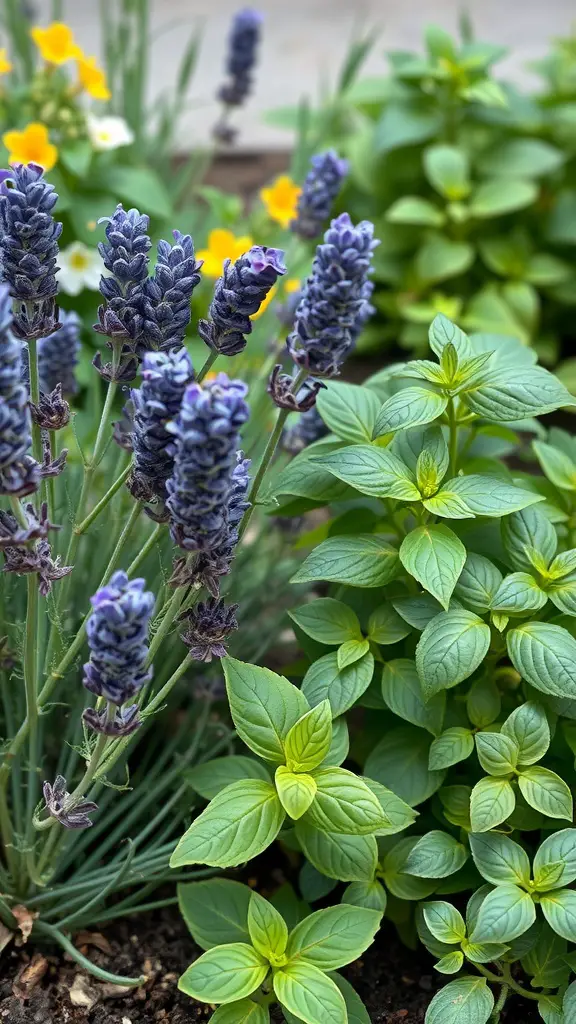
Lavender and basil make a delightful pairing in both the garden and the kitchen. The rich purple of lavender flowers contrasts beautifully with the vibrant green leaves of basil. This combination not only creates a visually appealing garden but also offers a fantastic aroma that fills the air.
In cooking, basil is a staple in many recipes, especially in Italian dishes. Its sweet and slightly peppery flavor complements lavender’s floral notes perfectly. You can use them together in various dishes, from salads to sauces.
To create a simple lavender basil pesto, gather fresh basil leaves, a few lavender flowers, olive oil, garlic, and nuts like pine nuts or walnuts. Blend these ingredients until smooth, and you’ll have a unique twist on the classic pesto. Spread it on toast or mix it with pasta for a fresh meal.
Planting these two herbs together not only enhances your culinary experiments but also benefits each plant. Lavender can attract pollinators, while basil thrives in the same conditions, creating a lively and productive garden space.
Cilantro and Beans: Thriving Together

Cilantro and beans make a lovely pair in the garden. In the image, you’ll notice healthy cilantro plants nestled happily among tall bean stalks. This combination not only looks good but also benefits both plants.
Cilantro, with its vibrant green leaves, grows well in the shade of the beans. The beans provide necessary support, while cilantro helps deter pests that might bother the beans. This partnership promotes healthy growth for both!
When planting these two together, consider the timing. Sow the beans first as they take longer to germinate. Once they’re a few inches tall, sprinkle in cilantro seeds. Both love a sunny spot, so make sure they get plenty of light.
If you’re thinking about recipes, cilantro can add a fresh kick to your bean dishes. Imagine a simple bean salad topped with bright cilantro leaves. Just mix cooked beans, chopped tomatoes, diced onions, and a handful of cilantro with lime juice for a refreshing meal.
Chives and Carrots: Flavorful Pairing

Chives and carrots make a delightful duo in the garden. The bright green chives stand tall with their thin leaves, while the vibrant orange carrots peek out from the soil, showcasing their earthy charm. This image beautifully illustrates their companionship, with chives flowering and adding a splash of white to the scene.
Growing chives alongside carrots isn’t just about aesthetics; it’s a smart choice for flavor and health. Chives add a mild onion flavor to dishes, enhancing the taste of carrots without overpowering them. Plus, they attract beneficial insects, which help keep pests at bay.
If you’re excited to use this pairing in your kitchen, consider making a simple carrot and chive salad. Just mix chopped fresh carrots with snipped chives, drizzle with olive oil, add a splash of lemon juice, and season with salt and pepper. It’s a bright, fresh dish that highlights the unique flavors of both ingredients.
Companion Planting Basics

Companion planting is all about nurturing plants that thrive together. In the image, we see a vibrant garden filled with various herbs, each labeled for easy identification. This layout not only makes it simple to know what’s planted where but also highlights the beauty of diverse herbs growing side by side.
When planting herbs together, consider how they can support each other. Some herbs can repel pests, while others attract beneficial insects. For example, planting mint near vegetables can help deter pests, while basil can enhance the flavor of tomatoes when grown alongside them. In this garden, each herb serves its purpose, making the space not just practical but also visually appealing.
A good mix of herbs like these can create an inviting atmosphere in your garden while promoting a healthy ecosystem. Experimenting with combinations can lead to discoveries about what works best in your space. Remember, the goal is to create harmony among your plants, ensuring that they flourish together.
Dill and Cucumbers: A Refreshing Combo

Dill and cucumbers are a match made in the garden. This pairing not only looks appealing but also adds vibrant flavors to your summer dishes. In the image, you can see a flourishing cucumber plant surrounded by dill, showcasing how well these two herbs grow together.
Cucumbers love the warm weather, while dill thrives in similar conditions. Planting them side by side maximizes space in your garden and allows them to support each other. The dill can help repel pests that might bother cucumbers, making your gardening efforts easier.
If you’re thinking of what to do with your fresh cucumbers and dill, try making a simple cucumber salad. Just slice some cucumbers, toss them with chopped dill, a sprinkle of salt, and a splash of vinegar. It’s a refreshing side dish that pairs perfectly with grilled meats!
Tarragon and Eggs: Culinary Partners

Tarragon and eggs make a delightful combination that brings out the best in each other. The image shows fresh tarragon leaves paired with eggs, highlighting this tasty duo. Using fresh herbs like tarragon can elevate simple dishes.
To enjoy this pairing, consider making a tarragon-infused omelet. You’ll need eggs, fresh tarragon, salt, and pepper. Start by whisking the eggs in a bowl and adding chopped tarragon. Heat a non-stick skillet, pour in the egg mixture, and cook until set. Fold it over, and you’ve got a tasty meal!
This simple recipe showcases how tarragon enhances the natural flavors of eggs. It’s a great way to start your day with something fresh and flavorful. Plus, growing tarragon in your garden is easy, making it a perfect herb to plant alongside your other favorites.
Lemon Balm and Fish: Flavor Enhancement

Lemon balm is a delightful herb that brings a fresh, citrusy flavor to many dishes. When paired with fish, it can elevate the taste and make your meal experience even more enjoyable. This image perfectly captures grilled fish, with vibrant lemon balm leaves surrounding it, highlighting how these two ingredients work together.
Grilling fish is a popular method that allows flavors to develop beautifully. The smoky, charred exterior of the fish complements the bright notes of lemon balm. The combination not only tastes good but also offers a visually appealing plate.
To create a simple yet tasty dish, you can use just a few ingredients. Start with fresh fish fillets, lemon balm, a lemon, and a drizzle of olive oil. Season the fish with salt and pepper, add a handful of lemon balm leaves and some lemon slices on top, and grill it until cooked through. The result is a meal that’s fresh, flavorful, and easy to prepare!
Fennel and Asparagus: Unique Companions
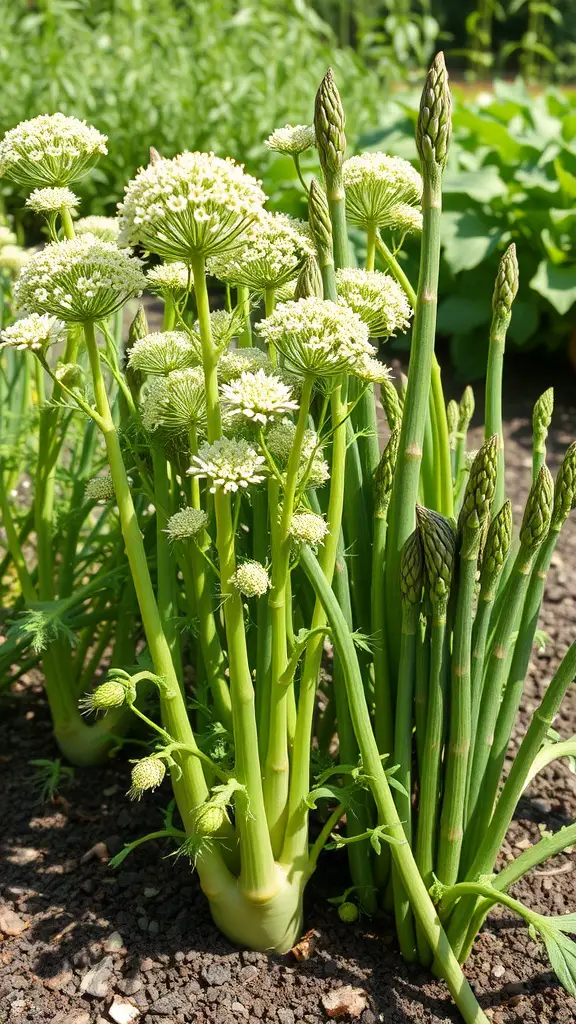
Fennel and asparagus are two herbs that thrive together in the garden. They create a beautiful partnership, combining their unique textures and flavors. In the image, you can see the tall, elegant stalks of asparagus standing proudly alongside the fluffy, white flower clusters of fennel. This pairing not only looks appealing but also offers benefits for growth.
Fennel can help repel pests that might bother asparagus, making it a smart choice for companion planting. Asparagus, on the other hand, provides a bit of shade for fennel during the hotter parts of the day. By planting them together, you’re nurturing both plants while also keeping your garden healthy.
Growing these two together can also enhance the flavors in your cooking. Imagine a dish featuring tender asparagus and the distinct anise flavor of fennel. You could simply roast them with olive oil and a sprinkle of salt, creating a simple yet delightful meal. Pair them with some grilled chicken for a fresh and flavorful dinner.
Oregano and Marjoram: Similar Yet Different
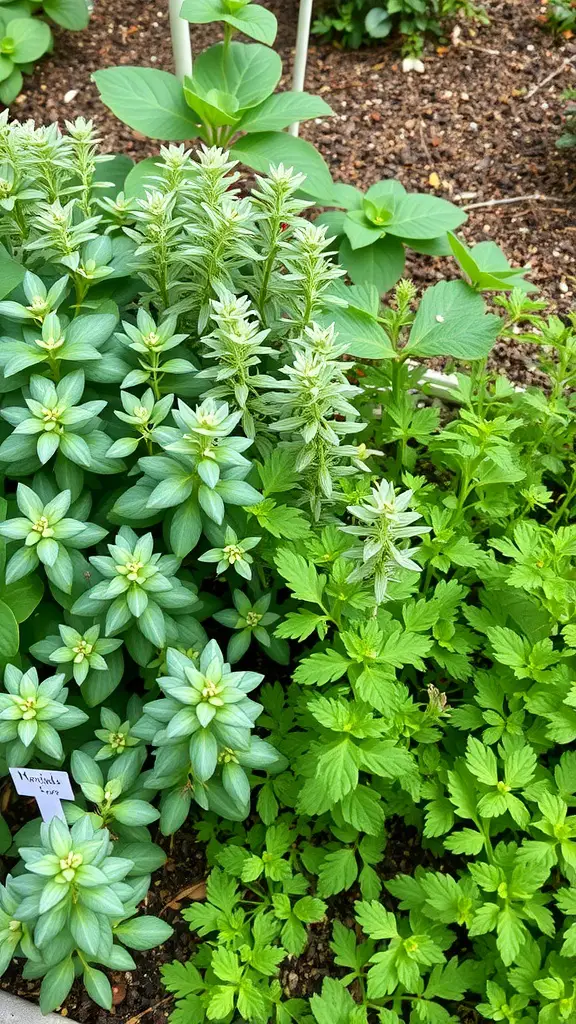
When it comes to herbs, oregano and marjoram often find themselves in the limelight together. Looking at the image, you can spot these two herbs thriving side by side in a garden bed. Oregano, with its robust leaves and slightly fuzzy texture, is a staple in many kitchens. In contrast, marjoram features softer leaves and a more delicate aroma, making it a favorite for seasoning lighter dishes.
While they may share a similar appearance, their flavors are distinct. Oregano tends to be bolder and sharper, which pairs well with hearty meals, like pasta and pizza. Marjoram, on the other hand, has a sweeter and milder taste, perfect for enhancing soups and salads.
Growing them together can be beneficial too. They thrive in similar conditions, enjoying warm weather and well-drained soil. Plus, having both in your garden means you can easily experiment with different recipes. Imagine a fresh pasta dish where you sprinkle in some oregano for that punch, while marjoram adds a touch of warmth.
So, whether you’re a seasoned chef or just starting out, consider planting these two herbs together. Their differences provide a delightful range of flavors that can elevate your cooking.
Parsley and Peppers: A Flavorful Duo
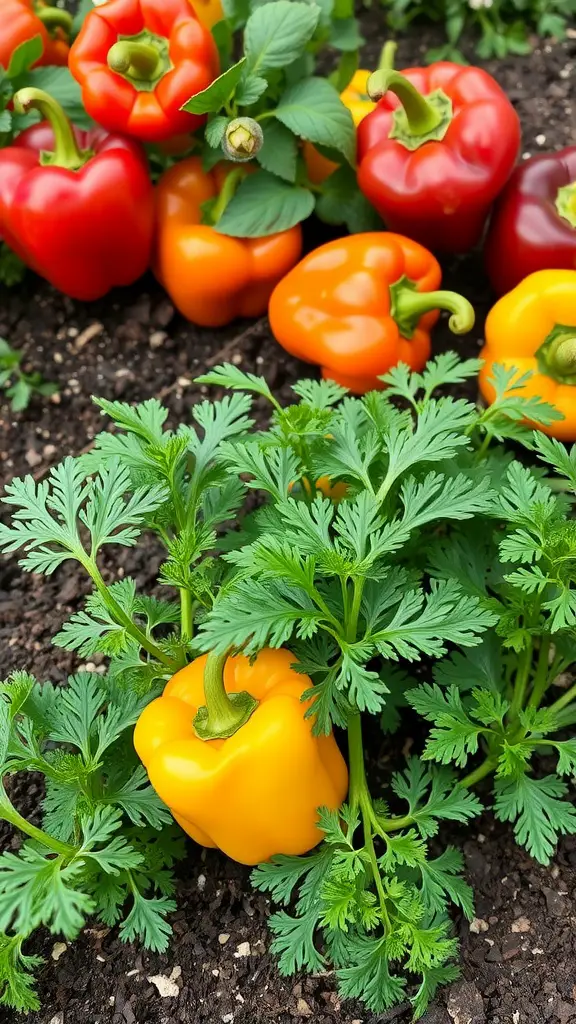
In the garden, parsley and peppers make a delightful pair. The vibrant colors of bell peppers—ranging from bright red to sunny yellow—stand out beautifully against the lush green of parsley. This combination not only enhances the aesthetics of your garden but also offers a variety of flavors for your dishes.
When you harvest parsley, its fresh and slightly peppery taste complements the sweetness of bell peppers perfectly. This duo can elevate many recipes, from salads to stir-fries. Imagine tossing chopped parsley with diced peppers for a refreshing salad or using them together in a savory stuffing for a roast.
To try them together, you can create a simple recipe. Just take some bell peppers, hollow them out, and fill them with a mixture of chopped parsley, rice, and your choice of protein. Bake until the peppers are tender, and you’ll have a tasty dish that highlights the flavors of both ingredients.
Bay Leaves and Beans: A Winning Combo

In the garden, bay leaves and beans can be a delightful pair. The lush green leaves of the bay plant stand tall next to the climbing beans. This image captures their vibrant growth, highlighting how they complement each other in a garden space.
Bay leaves, known for their fragrant aroma, bring a rich flavor to many dishes. When planted alongside beans, they help in maintaining overall garden health. The beans can thrive well in the shade provided by the taller bay plants. This relationship not only enhances growth but also makes gardening easier.
When you cook with these ingredients, you can create something delicious. Imagine a simple recipe where you simmer beans with a bay leaf for added depth. Just take some dried beans, soak them overnight, and then cook them with a few bay leaves, garlic, and onions. A dash of salt at the end ties it all together.
Growing bay and beans together is a smart choice, as they create a harmonious balance in the garden. Plus, the leaves can be harvested fresh for cooking! So, plant them close together and enjoy the benefits of this winning combo.
Mint and Cabbage: Natural Pest Control

Mint and cabbage are a fantastic duo in your garden. When grown together, they create a natural balance that can help keep pests at bay. The image shows vibrant mint plants surrounding a healthy cabbage head, illustrating how these two plants thrive side by side.
Mint has a strong scent that many pests dislike. This makes it a great companion for cabbage, which can attract unwanted insects. By planting mint around your cabbage, you can naturally deter pests without the need for harsh chemicals.
Not only does this pairing help with pest control, but it also promotes healthy growth. The lush green leaves of mint can help improve soil moisture, which is beneficial for the cabbage. Together, they create a thriving ecosystem in your garden.
Borage and Strawberries: Sweet Companions
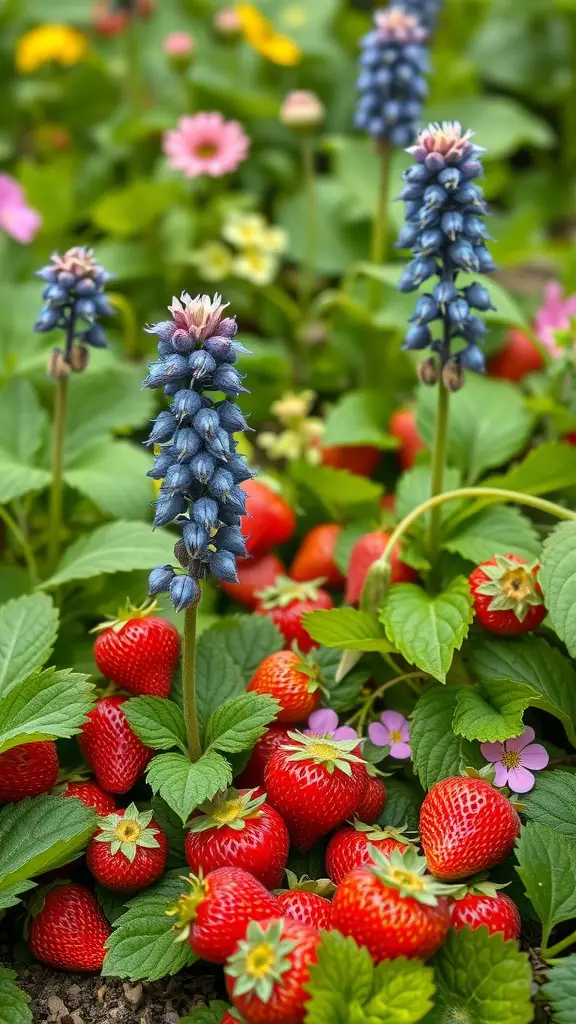
Borage and strawberries make a delightful pair in any garden. The bright blue flowers of the borage plant stand tall among the lush green strawberry leaves, creating a colorful and inviting scene. Strawberries, with their vibrant red hue, complement the borage beautifully, making this combination not just pleasing to the eye but also beneficial for growth.
Borage is known to attract pollinators, which can help increase strawberry yields. Plus, the leaves of borage can provide natural shade for strawberries, protecting them from the harsh sun. This companionship also keeps pests at bay, creating a healthier environment for your plants.
If you’re looking to plant these together, make sure to give them enough space. Strawberries spread out while borage can grow tall. This planting strategy can result in a bountiful harvest of sweet strawberries paired with the lovely presence of borage flowers in your garden.
Calendula and Herbs: Beauty and Utility
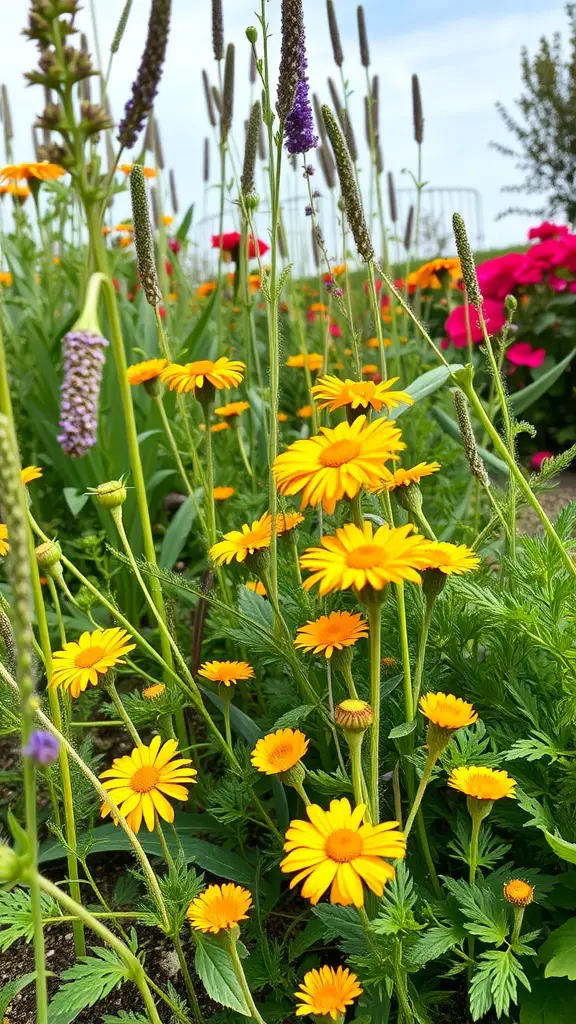
Calendula, with its bright yellow flowers, is not just a pretty face in the garden. It’s often paired with various herbs, adding both charm and functionality to your planting scheme. The image shows a vibrant patch of calendula blooming alongside other herbs and flowers, creating a lively garden scene.
These cheerful blossoms attract beneficial insects, which can help with pollination and pest control. Planting calendula with herbs like basil or thyme can encourage growth and enhance flavors. Plus, calendula petals can be used in salads or teas, offering delightful color and a hint of flavor.
Incorporating calendula in your garden can also boost the overall health of your plants. The flowers can help deter pests, meaning your herbs will thrive without chemical interventions. This makes calendula a perfect companion in both kitchen and ornamental gardens.
So, consider adding calendula to your planting list. Not only will it brighten up your outdoor space, but its benefits as a companion plant make it a smart choice for any herb garden.
Herbs for Pollinators: A Buzzing Garden
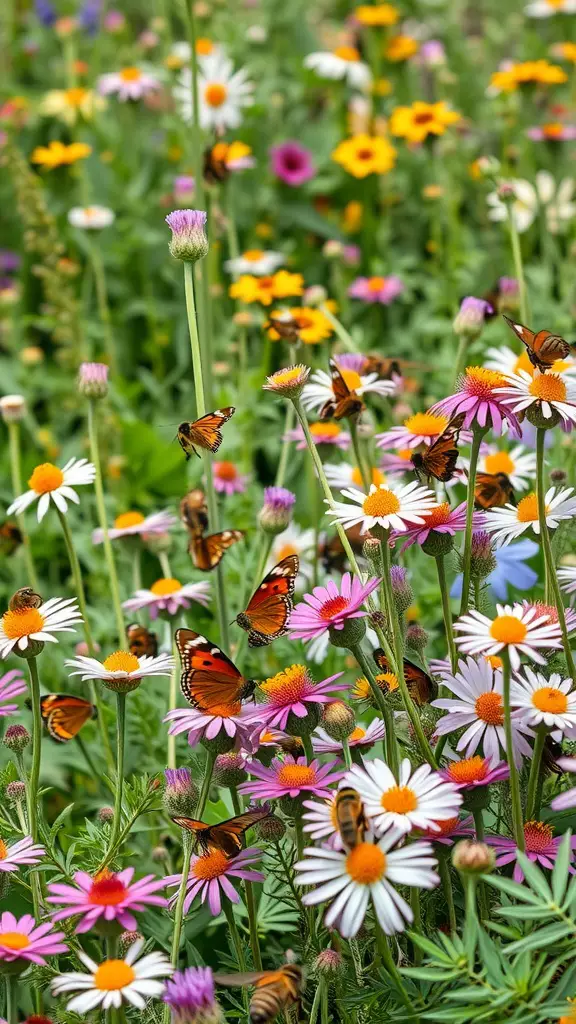
Creating a garden that attracts pollinators is not only beneficial for your plants, but it also brings life and color to your outdoor space. In the image, we see a vibrant patch of flowers buzzing with activity. Butterflies flutter around, drawn to the bright blooms. Incorporating herbs into this mix can further enhance your garden.
When choosing herbs, consider those that are known to attract pollinators. Herbs like basil, thyme, and mint produce small flowers that bees and butterflies love. Planting these alongside colorful blooms can create a wonderful ecosystem.
This lively scene reminds us that a diverse garden full of herbs and flowers is important for the environment. It supports not just the pollinators, but also the overall health of the garden itself.
Savory and Squash: A Flavorful Alliance

In the image, you can see a vibrant mix of herbs and squash plants growing together in harmony. The lush greenery creates a lively backdrop, showcasing the beauty of a well-planned garden. The yellow squash, peeking through the leaves, adds a pop of color that makes the whole setup inviting.
Planting savory herbs alongside squash is a smart choice. Herbs like rosemary and dill not only enhance the flavor of your dishes but also help to deter pests. This natural pest control means healthier plants and a more fruitful harvest.
When it comes to cooking, the combination of squash and savory herbs opens up a world of delicious recipes. Imagine slicing fresh yellow squash and tossing it with rosemary, olive oil, and a sprinkle of salt. Roast it until golden brown, and you have a simple yet tasty dish that highlights the natural flavors.
For those who enjoy gardening, planting these companions together supports biodiversity in your garden. It creates a balanced ecosystem, encouraging beneficial insects while keeping harmful ones at bay. Plus, watching them thrive together is a satisfying experience.
Culinary Herb Garden Layout

Creating a culinary herb garden is an enjoyable way to enhance your cooking. The image shows a well-organized layout with various herbs planted together, making it easy to identify and access each one. You can see labels for each herb, which is a helpful touch for beginners.
In the garden, you’ll find a variety of herbs like mint, basil, and cilantro, all thriving in their individual pots. This layout not only looks appealing but also allows for easy maintenance. Herbs typically grow well together, so grouping them can encourage healthier plants.
Consider planting herbs that have similar water and sunlight needs. For example, basil and cilantro can share a spot since they both enjoy plenty of sunlight. If you look closely, the vibrant greens of the herbs add a splash of color to your garden space, making it a delightful spot to spend time.
Whether you’re a seasoned chef or a kitchen newbie, having fresh herbs on hand can elevate your dishes dramatically. Imagine snipping off fresh mint for a refreshing drink or adding basil to your pasta – it’s a treat that can make your meals even more enjoyable.
Nasturtiums and Radishes: Edible Flowers
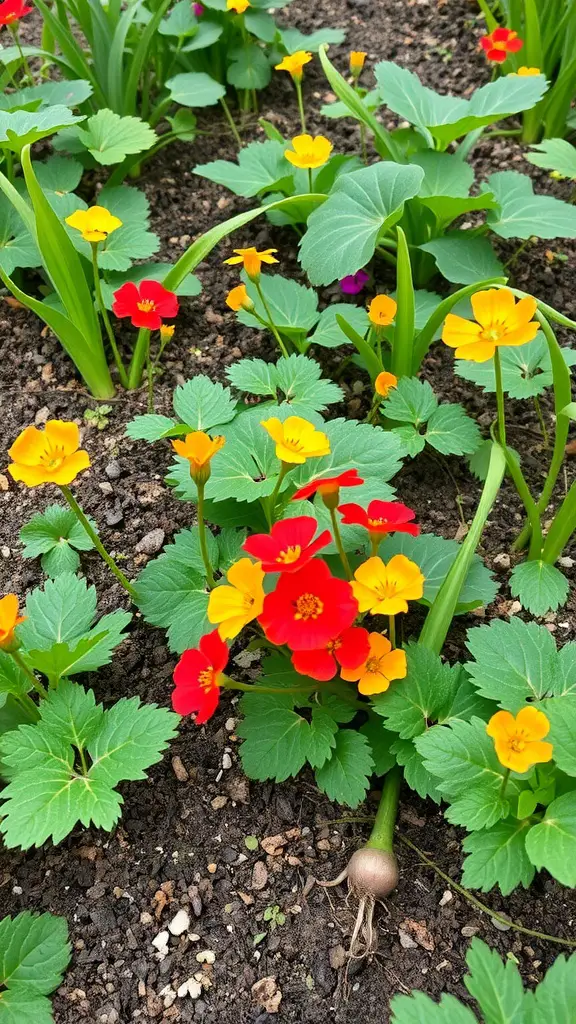
Nasturtiums are not just pretty flowers; they add a splash of color to your garden and pack a punch of flavor. With their bright red and yellow blossoms, they create a delightful visual feast. These edible flowers have a peppery taste, similar to arugula, making them a fun addition to salads or as a garnish.
In this image, you can see a lively patch of nasturtiums alongside radishes. Radishes are also a quick-growing crop, and their roots peek out from the soil, ready to be harvested. When planting nasturtiums and radishes together, you take advantage of their complementary growing habits.
The radishes grow underground, while nasturtiums spread across the surface. This combination not only makes efficient use of space but also helps in pest control. Nasturtiums can deter harmful insects, protecting your radishes and other nearby plants.
When you harvest nasturtium flowers, you can toss them into salads for a pop of color and flavor. Just be sure to wash them thoroughly before enjoying. Both these plants thrive in similar conditions, preferring well-drained soil and plenty of sunlight, making them ideal companions in the garden.
Herbs for Shade: Growing in Low Light

Growing herbs in shaded areas can be rewarding and enjoyable. The image shows a lush assortment of herbs thriving in a low-light environment. You might notice vibrant green leaves, indicating healthy growth. These herbs are perfect for those tricky spots in your garden where sunlight is limited.
When it comes to shade-loving herbs, options like mint, lemon balm, and chives stand out. Each of these herbs has unique flavors and uses. Mint is refreshing in teas and desserts, while lemon balm offers a lovely citrus aroma, perfect for infusing water or making herbal teas. Chives add a mild onion flavor to salads and dishes.
When planting herbs in shady areas, it’s essential to choose varieties that can tolerate less sunlight. Ensure the soil is well-draining and rich in nutrients. Regularly check for moisture, as shaded spots can hold water longer than sunny areas.
Creating a shade herb garden not only maximizes your growing space but also adds greenery and life to those dimmer areas. Plus, you can enjoy fresh herbs right from your garden, enhancing your cooking and beverages.
Herbs for Sun: Maximizing Sunshine
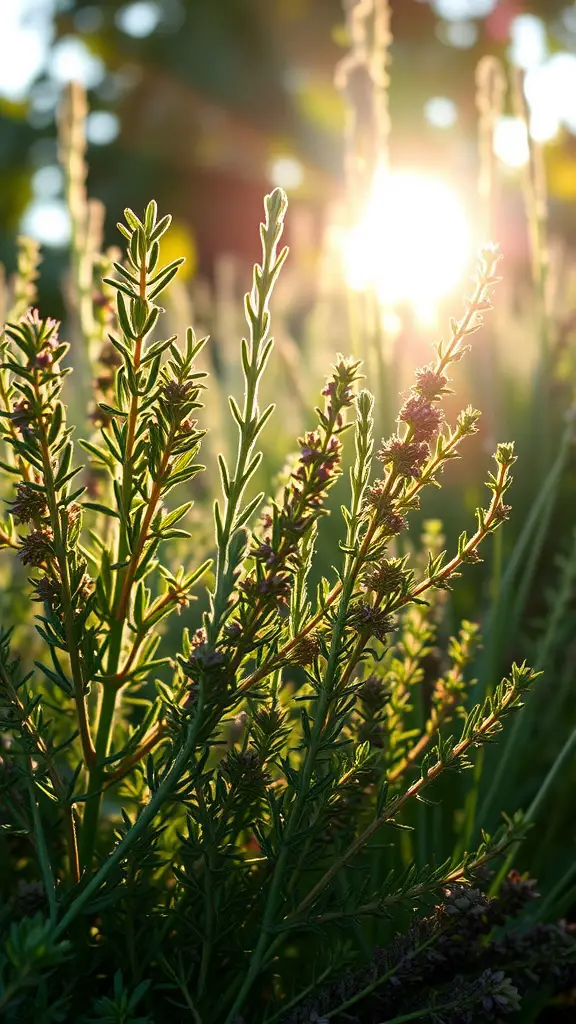
The image beautifully captures a collection of herbs basking in sunlight. The sun’s rays filter through the greenery, highlighting the unique shapes and textures of the leaves. This natural display reminds us how essential sunlight is for growing healthy herbs.
When planting herbs that thrive in full sun, consider options like rosemary, thyme, and sage. These herbs not only flourish under bright conditions but also bring delightful flavors to your kitchen. Planting them together allows for easy access when you’re cooking.
To create a sun-loving herb garden, start by choosing a sunny spot in your yard or on your balcony. Make sure the soil drains well. You can plant these herbs in individual pots or in a raised bed. Regular watering is essential, especially in hot weather, but be careful not to overwater.
Don’t forget to harvest your herbs regularly. This not only encourages new growth but also ensures you have fresh ingredients for your favorite dishes. Whether you’re making a savory stew or a refreshing salad, these sun-loving herbs will enhance your culinary creations.
Seasonal Herb Gardening Tips
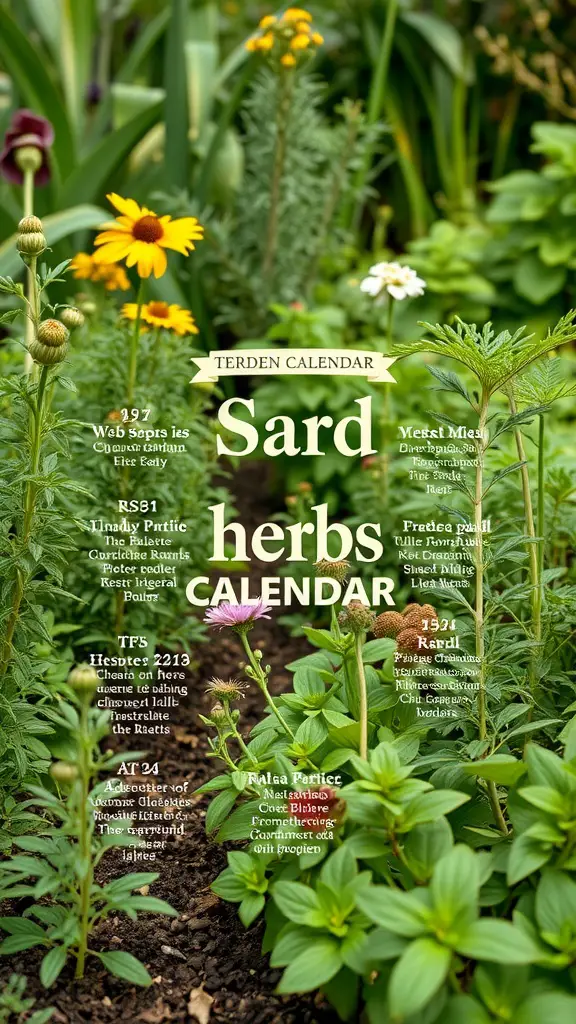
Gardening with herbs can be a delightful experience, especially when you consider the variety of plants you can grow together. The image shows a vibrant garden filled with various herbs and colorful flowers, creating a lively atmosphere. Seasonally planting herbs can enhance both the beauty and utility of your garden.
When planning your herb garden, think about companion planting. Some herbs thrive better when planted next to certain flowers or other herbs. For instance, basil pairs well with tomatoes and can even help repel pests. Meanwhile, mixing in some marigolds can attract beneficial insects to keep your garden healthy.
It’s also essential to consider the seasons when planting your herbs. Some herbs, like cilantro and parsley, prefer cooler temperatures, while others like basil and oregano thrive in warmer months. Always check the planting calendar to ensure you’re giving your herbs the best chance to flourish.
In addition, keep an eye on water and sunlight needs. Most herbs enjoy well-draining soil and plenty of sunlight. Be mindful of their growth patterns, so you don’t overcrowd your garden. This layout will allow each plant to receive the light and nutrients it needs.
Lastly, don’t forget to harvest regularly. Regular clipping encourages new growth and keeps your herbs healthy. Plus, you get to enjoy fresh herbs in your cooking!
Herb Spiral Design: Maximizing Space

The herb spiral is a unique gardening design that can transform your outdoor space. It maximizes the use of vertical and horizontal areas, making it easy to grow various herbs close together. The image showcases a beautifully arranged spiral filled with lush greenery and colorful flowers, illustrating how you can create an inviting herb garden.
In a spiral, the plants are layered by their water and sunlight needs. The top of the spiral is warm and dry, perfect for Mediterranean herbs like thyme and rosemary. As you move down, it becomes cooler and moister, suitable for herbs like mint and parsley. This layout not only looks attractive but also encourages biodiversity, helping to repel pests naturally.
To get started, you can build a simple spiral using stones or bricks. Fill it with your favorite herbs, and add companion flowers to attract pollinators. Make sure to choose herbs that will thrive together and complement each other. For example, basil and tomatoes are a classic pairing and can grow well in the same area.
Maintaining your herb spiral is easy! Regular watering and occasional pruning can keep the plants healthy and productive. Plus, you’ll enjoy the benefits of fresh herbs right from your garden, enhancing your cooking and providing a delightful aroma.
Growing Herbs in Containers

Container gardening is a fun and practical way to grow herbs, especially if you have limited space. The image showcases a lovely collection of potted herbs, which can thrive in a small area like a patio or balcony.
Each pot holds a different variety, from mint and basil to rosemary and parsley. This mix allows you to have a variety of flavors at your fingertips. You don’t need a big backyard to enjoy fresh herbs; just a few pots can do the trick!
When choosing pots, make sure they have good drainage. Herbs generally prefer well-draining soil, so look for containers with holes at the bottom. You can use standard plastic pots or get creative with decorative options to brighten up your space.
Grouping pots together, as shown in the image, not only saves space but also creates a lush look. Plus, some herbs can benefit from the shade of taller plants. Planting herbs together can also help attract pollinators to your garden.
Don’t forget to monitor your herbs regularly. They need enough sunlight, water, and occasional feeding to grow well. With a bit of attention, you’ll have a thriving herb garden right at your doorstep!
Creating an Herb Garden for Beginners

Starting your own herb garden can be a fun and rewarding experience. Just look at this image of a vibrant herb garden filled with various plants. You can see labeled sticks for each herb, which is a smart way to keep track of what you’ve planted.
In the foreground, lush green leaves suggest healthy plants ready for harvesting. Herbs like basil, parsley, and mint are perfect for beginners due to their forgiving nature. They thrive in various conditions and add fresh flavors to your meals.
To create your own herb garden, begin by choosing a sunny spot in your yard or balcony. Most herbs need at least six hours of sunlight each day. You can plant them in the ground or in pots if space is limited.
Once you’ve picked your herbs, prepare the soil. A well-draining potting mix works well for potted herbs. If you’re planting in the ground, make sure the soil is loose and enriched with compost.
Water your herbs regularly but avoid overwatering. It’s important to let the soil dry out slightly between waterings. As they grow, you can enjoy snipping fresh leaves to enhance your cooking. Remember, herbs can also attract beneficial insects, which help in maintaining a balanced garden ecosystem.
Preserving Herbs for Year-Round Use

When it comes to enjoying fresh herbs all year long, preserving them is key. The image above showcases a lovely display of jars filled with vibrant, green herbs on a simple wooden shelf. Each jar offers a glimpse into the different flavors and aromas that can elevate your meals, even in the cold months.
Using jars to store your herbs is a great way to keep them fresh and flavorful. You might see jars filled with everything from basil to rosemary, each clearly labeled and ready for use. This method not only preserves the herbs but also makes it easy to find what you need when you’re cooking.
There are various ways to preserve your herbs. You can dry them, freeze them, or even make herb-infused oils. For drying, simply hang bunches upside down in a cool, dark area until they are crisp. For freezing, chop your herbs and mix them with a little water in ice cube trays. This way, you’ll have easy-to-use herb cubes ready for soups or sauces.
If you’re looking for more flavor, consider making herb-infused oils. Just combine your favorite herbs with oil in a jar, let it sit for a couple of weeks, and you’ll have a delicious addition to your pantry. This can enhance your salads, marinades, and more.
Harvesting and Using Your Herbs

When it comes to harvesting herbs, timing is key. The image shows a lovely basket filled with freshly picked herbs, bursting with vibrant green colors. These herbs can add a fresh touch to your dishes, making meals more flavorful.
To start, grab a pair of sharp scissors or garden shears. Cut the stems just above a leaf node to encourage new growth. Aim to harvest in the morning when the essential oils are at their peak. This is when your herbs will be most aromatic and flavorful.
Once harvested, you can use your herbs right away or dry them for later use. For fresh herbs, chop them finely and toss them into salads, soups, or sauces. If you prefer dried herbs, tie them in small bundles and hang them upside down in a cool, dark place. After a few weeks, they will be ready to store in jars.
Using your herbs is all about experimentation. Add them to simple recipes like scrambled eggs, pasta, or grilled vegetables. Don’t forget to pair different herbs together for a unique flavor blend. For example, basil and parsley go well together in pesto, while rosemary and thyme are perfect for roasted meats.
Herbs not only enhance the taste but also bring health benefits. Many herbs have anti-inflammatory and antioxidant properties. So, enjoying them in your meals can be a tasty way to support your well-being.
Composting for Healthy Herbs

Looking at this image, you can see a lovely herb garden in a planter. It’s filled with vibrant green plants like basil and mint, alongside some fresh vegetables. The mix of herbs and veggies shows how well they can thrive together, especially when grown with good compost.
Composting is essential for nurturing healthy herbs. When you add compost to your garden, it improves soil structure and provides nutrients. This helps your herbs grow strong and flavorful. In the image, the rich, dark soil is likely a result of composting, making it perfect for these plants.
Using kitchen scraps and yard waste in your compost bin is a great way to create your own nutrient-rich soil. Things like vegetable peels, coffee grounds, and dried leaves can break down and enrich the soil. This practice not only benefits your herbs but also reduces waste, making it eco-friendly.
Incorporating compost into your gardening routine can lead to happier, healthier plants. The herbs in this image appear thriving and vibrant. They’re not just pretty to look at; they’re likely bursting with flavor, perfect for cooking. So, give composting a try, and watch your herbs flourish!

